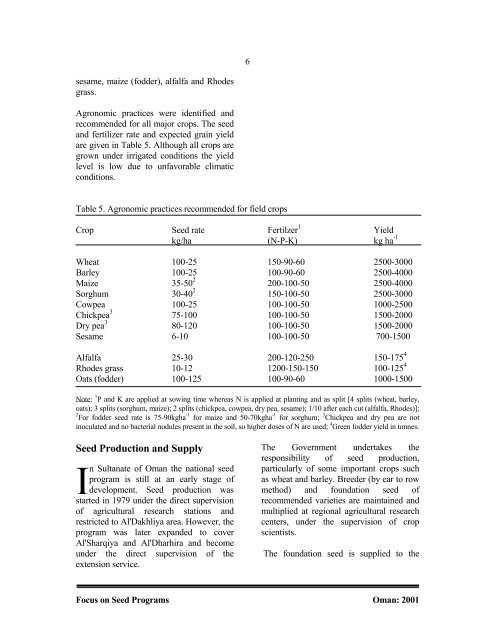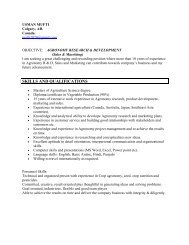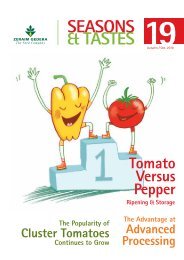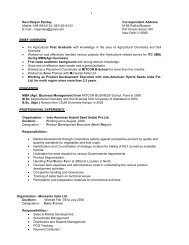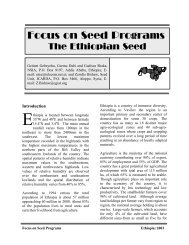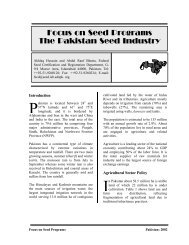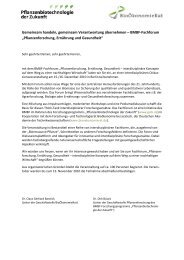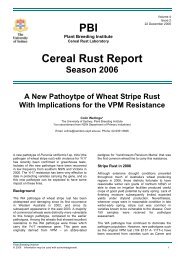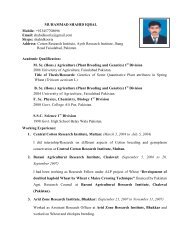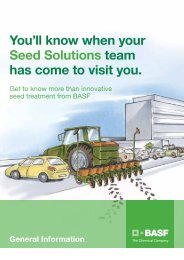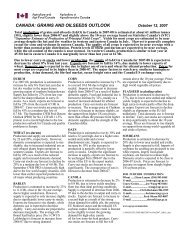Focus on Seed Programs The Seed Industry in Oman - SeedQuest
Focus on Seed Programs The Seed Industry in Oman - SeedQuest
Focus on Seed Programs The Seed Industry in Oman - SeedQuest
Create successful ePaper yourself
Turn your PDF publications into a flip-book with our unique Google optimized e-Paper software.
6<br />
sesame, maize (fodder), alfalfa and Rhodes<br />
grass.<br />
Agr<strong>on</strong>omic practices were identified and<br />
recommended for all major crops. <strong>The</strong> seed<br />
and fertilizer rate and expected gra<strong>in</strong> yield<br />
are given <strong>in</strong> Table 5. Although all crops are<br />
grown under irrigated c<strong>on</strong>diti<strong>on</strong>s the yield<br />
level is low due to unfavorable climatic<br />
c<strong>on</strong>diti<strong>on</strong>s.<br />
Table 5. Agr<strong>on</strong>omic practices recommended for field crops<br />
Crop <strong>Seed</strong> rate Fertilzer 1 Yield<br />
kg/ha (N-P-K) kg ha -1<br />
Wheat 100-25 150-90-60 2500-3000<br />
Barley 100-25 100-90-60 2500-4000<br />
Maize 35-50 2 200-100-50 2500-4000<br />
Sorghum 30-40 2 150-100-50 2500-3000<br />
Cowpea 100-25 100-100-50 1000-2500<br />
Chickpea 3 75-100 100-100-50 1500-2000<br />
Dry pea 3 80-120 100-100-50 1500-2000<br />
Sesame 6-10 100-100-50 700-1500<br />
Alfalfa 25-30 200-120-250 150-175 4<br />
Rhodes grass 10-12 1200-150-150 100-125 4<br />
Oats (fodder) 100-125 100-90-60 1000-1500<br />
Note: 1 P and K are applied at sow<strong>in</strong>g time whereas N is applied at plant<strong>in</strong>g and as split [4 splits (wheat, barley,<br />
oats); 3 splits (sorghum, maize); 2 splits (chickpea, cowpea, dry pea, sesame); 1/10 after each cut (alfalfa, Rhodes)];<br />
2 For fodder seed rate is 75-90kgha -1 for maize and 50-70kgha -1 for sorghum; 3 Chickpea and dry pea are not<br />
<strong>in</strong>oculated and no bacterial nodules present <strong>in</strong> the soil, so higher doses of N are used; 4 Green fodder yield <strong>in</strong> t<strong>on</strong>nes.<br />
<strong>Seed</strong> Producti<strong>on</strong> and Supply<br />
In Sultanate of <strong>Oman</strong> the nati<strong>on</strong>al seed<br />
program is still at an early stage of<br />
development. <strong>Seed</strong> producti<strong>on</strong> was<br />
started <strong>in</strong> 1979 under the direct supervisi<strong>on</strong><br />
of agricultural research stati<strong>on</strong>s and<br />
restricted to Al'Dakhliya area. However, the<br />
program was later expanded to cover<br />
Al'Sharqiya and Al'Dharhira and become<br />
under the direct supervisi<strong>on</strong> of the<br />
extensi<strong>on</strong> service.<br />
<strong>The</strong> Government undertakes the<br />
resp<strong>on</strong>sibility of seed producti<strong>on</strong>,<br />
particularly of some important crops such<br />
as wheat and barley. Breeder (by ear to row<br />
method) and foundati<strong>on</strong> seed of<br />
recommended varieties are ma<strong>in</strong>ta<strong>in</strong>ed and<br />
multiplied at regi<strong>on</strong>al agricultural research<br />
centers, under the supervisi<strong>on</strong> of crop<br />
scientists.<br />
<strong>The</strong> foundati<strong>on</strong> seed is supplied to the<br />
<str<strong>on</strong>g>Focus</str<strong>on</strong>g> <strong>on</strong> <strong>Seed</strong> <strong>Programs</strong> <strong>Oman</strong>: 2001


